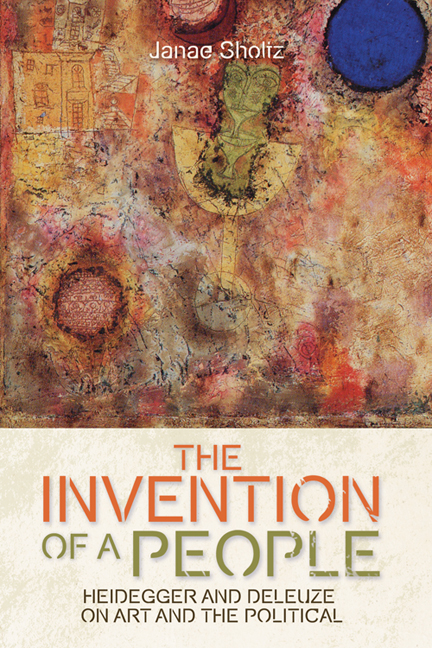Book contents
- Frontmatter
- Contents
- Acknowledgments
- Abbreviations
- Introduction: The People Are Missing
- PART I DIVERGENCE, THE POINT OF NIETZSCHE
- PART II (UN)THINKING, WHAT MUST BE THOUGHT
- Introduction to Part II
- 3 Heidegger on Art and Ontology
- 4 Deleuze on Art and Ontology
- PART III (UN)EARTHING A PEOPLE-TO-COME
- CONCLUDING EVENT
- Index
Introduction to Part II
from PART II - (UN)THINKING, WHAT MUST BE THOUGHT
Published online by Cambridge University Press: 05 August 2016
- Frontmatter
- Contents
- Acknowledgments
- Abbreviations
- Introduction: The People Are Missing
- PART I DIVERGENCE, THE POINT OF NIETZSCHE
- PART II (UN)THINKING, WHAT MUST BE THOUGHT
- Introduction to Part II
- 3 Heidegger on Art and Ontology
- 4 Deleuze on Art and Ontology
- PART III (UN)EARTHING A PEOPLE-TO-COME
- CONCLUDING EVENT
- Index
Summary
The comparative reading of Heidegger and Deleuze has prepared the path for a discussion of the transformative potential of art as a prelude to the question of the political. Each thinker places the philosophic tradition into question, seeking a transformation, whether as another beginning or a new image of thought, through an engagement with philosophy's limits, which is to say the limits of thought. Thus both are interested in difference: between being and beings, between thought and being, and, as we have argued before, both recognise a fundamental requirement of conceiving these differences outside of the framework of dualism, immanently. Heidegger and Deleuze are invested in articulating modes of thinking that do not transcend the matter to be thought, but instead unfold out of it. In fact the fold is a major trope for both thinkers, and one that indicates the difference between their respective positions. In other words, the issue of thinking for both is the original event of thought's occurrence.
In a 1978 series of lectures on Kant, Deleuze makes a brief, yet illuminative, reference to Heidegger in relation to the organising idea of the unthought, specifically citing his oft-quoted phrase that ‘we have not yet begun to think’. Deleuze identifies the problem of time and its relation to thought as a continued legacy passed down through Kant. ‘From Kant onward, philosophy will give itself the task of thinking what is not thinkable, instead of giving itself the task of thinking what is exterior (extérieur) to thought … the direct line from Kant to Heidegger is truly the problem of time and its relation to thought.’ The relation between the form of receptivity (time) and the form of activity (thought), a relation which Deleuze, following Kant, describes as heterogeneous and irreducible, essentially implicates the ungroundedness of thought, and it is clear that Deleuze views Heidegger as working within this problematic. Since both recognise the Ab-grund, the foundationless or ungrounded, their difference can be thought in terms of how to conceive founding or commencement. How does one begin (to think) again and how does one conceive the relation between thinking and being?
- Type
- Chapter
- Information
- The Invention of a PeopleHeidegger and Deleuze on Art and the Political, pp. 73 - 82Publisher: Edinburgh University PressPrint publication year: 2015

